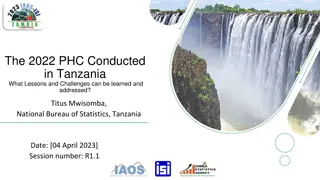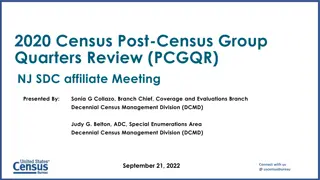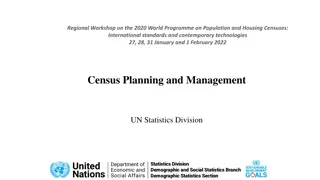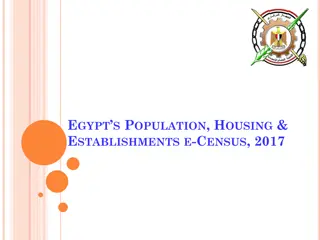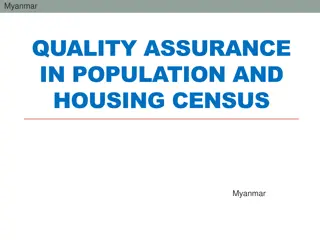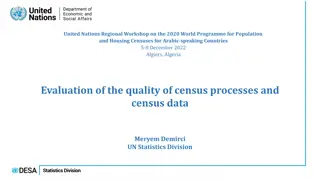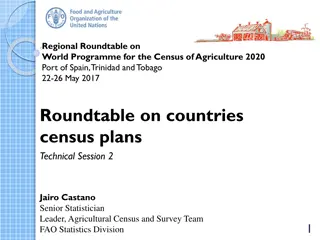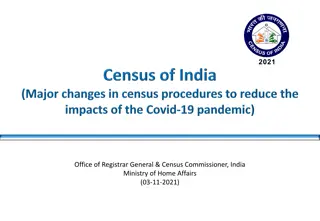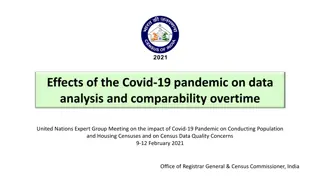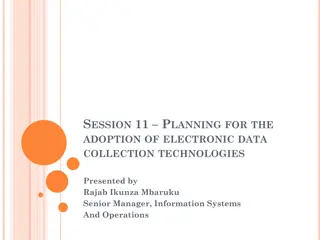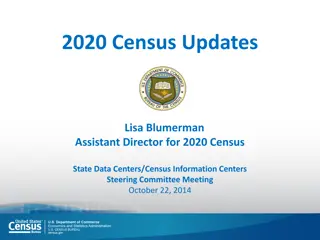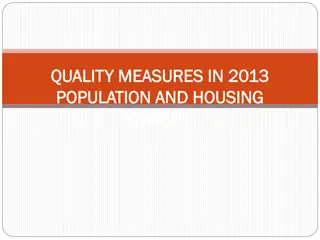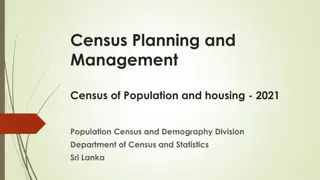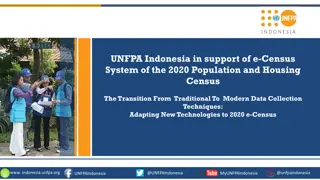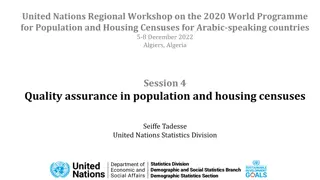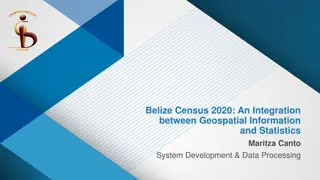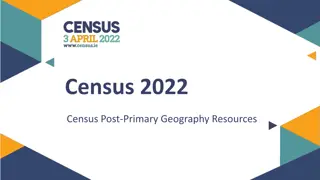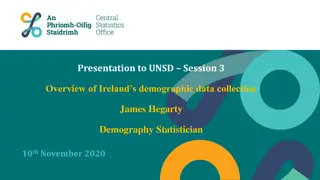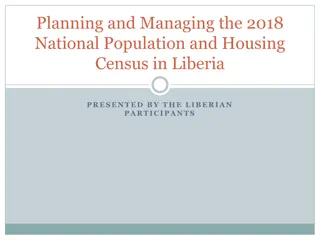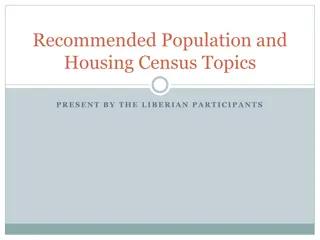Egypt 2017 Census: Strategic Objectives and Goals
The Egypt 2017 Population, Housing, and Establishment Census focused on strategic objectives such as full population coverage, confidentiality of data, and adherence to quality standards. The goals included involving stakeholders, achieving compliance within budget and timetable, and ensuring a well-trained field labor force. Timely availability of instruments and census publicity were also highlighted to maximize the census's impact and effectiveness.
Uploaded on Sep 14, 2024 | 0 Views
Download Presentation

Please find below an Image/Link to download the presentation.
The content on the website is provided AS IS for your information and personal use only. It may not be sold, licensed, or shared on other websites without obtaining consent from the author. Download presentation by click this link. If you encounter any issues during the download, it is possible that the publisher has removed the file from their server.
E N D
Presentation Transcript
Mr. Abdelhamid Sharaf Eldin Dr. Shaker A. El-Naggar Central Agency for Public Mobilization And Statistics (CAPMAS) Egypt 1
Egypt 2017 Population, Housing and Establishments Census (Census Planning and management) 2
Contents Introduction. Strategic objective for the census operation. Census Forms (Short & Long Forms). Census Management Structure. Capacity Development. Collaboration with partners. Communication Strategy. Census operations: Cartographic and mapping; Field operations ; Pilot test. Quality Assurances. Adoption of Technology & Publication for Census Challenges 3
Introduction The Egypt 2017 Population, Housing and Establishment census is the 14thin a long history of census taking in recent history, since 1882. Preparations for the current census were initiated immediately after the conclusion of the latest census (2006), where it benefited from lessons learned, the findings of the PES as well as the Recommendations Housing Censuses (Revision 2 & draft 3). 4 UN for Principles Population and and
Population in Census Years 2017 Expected:93 Population in (Millions) Population in (Millions) year year 72.8 2006 1996 59.3 48.2 1986 1976 36.3 30.1 1966 1960 26.1 Census 18.9 1947 1927 15.9 2017 14.2 1937 1917 12.7 No.14 11.2 1907 1897 9.7 6.7 1882 5
Strategic objective for the census operation 6
Strategic Goals Census returns are responsive to the needs of various users through involving various stakeholders in the process of specifying census content. Full coverage of the population and reduced no- compliance is achieved within budget and timetable. Confidentiality of individual responses protected: data collection and dissemination of findings fully comply with legal and ethical standards. Quality standards well established in the Production of census results within a predetermined time table. 7
Strategic Goals (cont.) while maintaining quality Cost-effectiveness requirements at all levels. High-quality field labour force recruited and trained according to transparent criteria and procedures. Census publicity to ensure that the public is well informed about the importance of the census and its benefits. Timely availability of all instruments (maps, tablets,..) and standardized procedures in all regions. Accountability at all levels. 8
Strategic Directions Type of enumeration: obtaining population counts by both place of usual residence and place of enumeration (all previous censuses approach). Household/ individual conditions information are to collected through two forms: Long Form: collected enumerated households; Short Form: covering the balance (90%). However its content are fully covered by the long one. adopted extended de-facto characteristics and living from about 10% of 9
Strategic Directions (cont.) Collecting interviewers enumeration through the internet. Central planning implementation is fully decentralized. Training at the local levels is to be carried out using TOT approaches and standardized materials prepared on CD covering major concepts, definitions and guidelines. ) The scientific material was prepared to explain the census forms on a video to unify census concepts( information (Tablets) through and face-to-face encouraging self- and established systems while 10
Strategic Directions (cont.) Based on the above well-defined population and housing census features, the Electronic census is: - A full computerization of all census processes, at all levels, through both the tablet, the internet and the utilization of digital maps; - Establish secured direct connection between field workers and the Data Center (DC) at headquarter to transfer the data to the national data base; - Establish and sustain a supportive technological environment for centrally managing the tablet, follow-up field work and establish effective mechanisms to provide immediate necessary support to census workers and users to ensure successful implementation of all census processes. 11
Strategic Directions (cont.) Adopting Blocks as the basis for recording and numbering buildings, housing units and households in rural and urban areas (previous censuses were using roads in Urban areas). Establishing Data Ware-House (DWH) that can serve as a storage for such big data and for integrating information collected through various Forms. 12
Census Forms 13
Short Form Information about the location including building address and the name of owner; Name of HH head (or respondent) and tel. no.; Table (1): covering individual characteristics, Number and name of resident , Relationship to head of household, Presence status (usual resident, usual resident but currently absent (< 6 months), present but not resident, Age, sex, religious, nationality, Education status and highest degree, Marriage status and no. of wife's, Table (2): living conditions and household, ownership; 14
Long Form Table (1): The first part is replicating all the information covered in the short Form up to educational status; Additional questions about: drop out from education and reasons; Utilization of information technology; Economic characteristics 18/04/2017(for those 6+); Duration of stay in current residence in years; For those who changed their residence sine 2006, previous place of residence and reason for movement; For all disabled persons to specify type of disability and causes for disability , according to the Washington Group . for the week ending on 15
Long Form (cont.) Table ownership and extended list of household home appliances; (2) : living conditions, household Table (3): Garbage disposal 16
Censuses Management Structure 17
Census Management Structure CAPMAS assumes full responsibility for the overall management of the census and its Chairman is the top management officer. The Supervisor General for the census is responsible for coordinating and following-up all census activities. At the central level, Various CAPMAS sectors are responsible for various areas of work according to their mandate. This include: Population and Census Sector (key subject matters and the executive census director); Regional Offices Sector (field operations); IT Sector (cartography, data processing, e-enumeration & tablets); Quality Control Department (assessment of various activities) Administration Sector (logistics, printing, .) 18
Regional Management of the Census For Census activities, Egypt is divided into 4 central regions that will be fully decentralized (Field work operation). Each cover between 4-9 Governorates. These regions are: Greater Cairo; Lower Egypt; Upper Egypt; and, Suez Canal zone. At local level, overall Egypt is divided into 70 census area. Each will be headed by a General director and a number of assistants. The following levels include field Supervisors (inspectors), crew leaders and enumerators. 19
Field Work Structure Responsible for implementing all the procedures for facilitating census Coordinator activities in the governorates Responsible for implementing all census procedures in his area(part of the Supervisor governorate) as well as collecting data from 160 t to 220 thousand unit & from 60 to 80 thousand household. The first circle of field activity, he is responsible for implementing & following up census procedures in his area(Shiakha/village.. Or more) as well as Inspector collecting data from 16000-22000 unit(housing or non-housing) and from 6000 to 7500 Household. Responsible for collecting data from 1600- 2200 Unit & from 600-750 Household Assistant Responsible for the Assistant tasks in the enumeration area which has more households than the previous. Co-Assistant 20
Field Work Structure Number of workers in E-census (2017) Co-assistant Supervisor Inspector Coordinator Total Assistant 17000 25000 2500 275 38 44813 Number of workers in the previous census (2006) Total General supervisor Enumerator Assistant Inspector supervisor 114165 25000 2500 2500 79 142019 21
Capacity Development 22
Capacity Development Consider institutional memory. Capacitating through 2020 RPHC Workshops. Short term trainings. Training of Trainers (TOT). census personnel
Capacity Development Snowball - Selection of 50 trainers from the best staff, trained to become Trainers (TTOT). - Then 507 trainers were selected and trained to be trainers (TOT) ,Snowball 6 groups. - These trainers conducted local training for 504 training points with a total of about 45,000 field assistants.
Census 2ndversion UN 2006
6 snowball courses 507 Trainers
Collaboration With Partners 30
Collaboration with Partner Government Institutions Local Government Institutions UNFPA NGOs Private sector 31
Participation and Coordination at Central and regional levels High level Committee for Census The High-Level Committee for the Census was established by a Prime Minister Decree including all related Ministries as well as representatives of the private sector and civil Societies. It is headed by the Minister for Local Development and CAPMAS Chairman is his deputy. Census Committee in the governorates At Governorates level, similar Committees for the census were established to facilitate all activates and provide needed support. 32
Partners Partners - AOI TPC / Intel - Efinance - Telecom Egypt - Tedata - - MCS Provide and maintenance of tablets Backup data Center DR Phone lines & data transmission Technical support, call center, centralized remote tablet management system MDM oCAPMAS - Microsoft MOMP -Global Knowledge oMCIT oMPMAR Printing Spatial number card Review of applications, providing consultations and technical support to the IT system administrators - - Link - Orange ESRI - Vodafone Application development and training Providing internet services for data transmission and closed Mobile network 33
Communication Strategy 34
Communication Strategy Reach out to all population Media Workshops Roadshows Schools
Publicity and awareness campaign Based on the experience of the 2006 census, it is planned to undertake campaign to increase awareness, foster high-level response with accurate data. Moreover, the plan would include direct contacts with special groups including school and university students, NGOs and executives. Collaboration with some respect is underway (developing relevant curricula with Ministry of Education and providing locations for census publicity with the Ministry of Transportation). a full-scale publicity governorate leaders and Ministries in that 36
Census Operations 37
Cartographic and Mapping Since 2013, CAPMAS embarked on a major project to prepare updated census maps for all governorates covering both urban and rural areas. It is fully completed on March 2016. Maps at different scales were created for various census levels of supervision. This include maps for census area field director, supervisor/inspector, crew leaders and enumerators. These are to ensure full coverage and avoid overlap at all levels. In addition to field operations, the GIS system would provide an opportunity for the presentation of census results. 38
Field Operation Stages 2- Second stage Preparatory stage 3- Third stage 1- First stage stacking Enumerating buildings &units (Housing or Non-housing) Enumerating population &housing conditions Enumerating establishments and their characteristics &numbering buildings and blocks in urban &rural areas The period from 21/1 29/1 2017 The period from 1/2- 20/3 2017 The period from 18/4-26/5 2017 The period from 10/6-10/7 2017 39
Statistical Estimates Field Activity starts from 21 January to 10 July. Field activity includes 4 stages are: 1- Stacking & numbering 11 days 2- Building Enumeration 33 days Number of buildings 15 Million 3- Population counting- 28 days Households- 24 Million Individuals 93 Million 4- Enumerating establishments 30 days Establishments 7 Million
Census Tests CAPMAS concluded Five census tests, as follows : First census test: was carried out in 2013 and covered a total of 8000 HHs in two Governorates (Cairo and Kalyubia); Second test : was carried out in 2013/2014 and covered a total of 37000 HHs in three Governorates (Ismailia, al Gharbia and Fayoum); Third test: was carried out in 2014/2015 and covered a total of 100 thousands in 10 Governorates. The fourth census test: was initiated in September 2015 and would be concluded by end of January 2016. it will cover around 23 thousand HHs in two Governorates (Kalyubia and Assuit). It is planned to be a complete replica of final census operations including the Tablet. 41
The Fifth census test Fifth pre-test aimed to test using electronic software application for all census phases(preparations-determining work areas- drawing, matching and modifying geographical maps counting unites & buildings counting population and housing conditions using 2 questionnaires (short & long) - Counting public housing counting establishments). This includes practical tests for the following: Tablet Management system (MDM), system of secure data transfer over the Internet. Follow-up work performance and field work, report operating rooms and electronic tracking system (Administration Application). Quality assurance of field data collection through communication field follow up. Tracking implementation performance rates, at various levels, and rates of errors and census quality indicators. Getting Final results within one week after the end of the pre-test putting of the basic results and indicators on a geographical atlas maps. & Management Software 42
Fifth pre-test Human recourses The fifth pre-test has been conducted in the field during the period from 10/7/2016 to 5/9/2016 in all governorates Administrativ e Unit Assistant Supervisor Inspector Coordinator Region 25 35 126 930 769 171 No. Buildings No. Units No. Families No. Establishments 74 thousand 182 thousand 89 thousand 26 thousand 43 43
Quality Assurances 44
Quality Assurance Processes Emphasizing the key role of census managers, at all levels, in establishing quality, through: Developing criteria for selecting mangers including abilities to build team work and focus on problem solving; Ensure their responsibility for diffusing the culture of quality and its implementation at all stages; Clarity of responsibilities of all and ensure that these are well understood and documented. Document processes and assess their outcomes to draw lessons and involve staff in identifying and resolving deficiencies with quality. Adopt culture emphasizing that quality systems focus on correcting processes rather that detecting errors. 45
Quality Assurance Processes (cont.) Adopt timely quality control plan, at all field levels, to assess and test the efficiency of various census processes. Expand and continue the functions of the Call Center of CAPMAS, as a mechanism to involve the public at large in securing full coverage for each stage of the census. Develop plans for evaluating including post enumeration survey (PES). census results 46
Adoption of Technology & Publication for census 47
Adoption of Technologies for Census Building conducting the census according to the statistical scientific basis applied internationally to provide statistical data through: Tablet + Application + Electronic Geographic Maps. Data transfer networks + data center + data security Support users + Instant communication with employees an integrated technological system for
Census outcomes Publications Census tabulation plan is already developed and is being prepared by the IT sector. These Include specific reports at the National level and for each governorate. Producing census atlas at various levels. Introducing census results on the Website of CAPMAS and Censusinfo, confidentially and privacy aspects. after ensuring 49
Challenges 50


